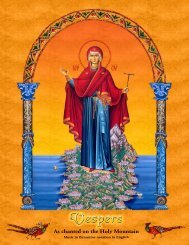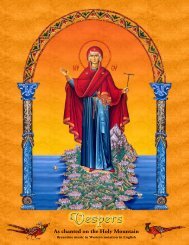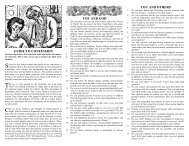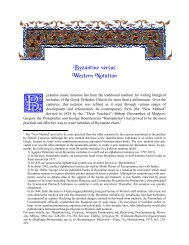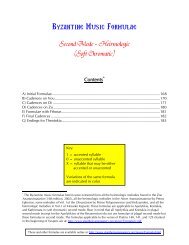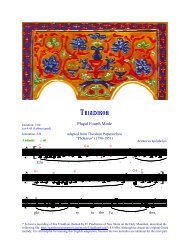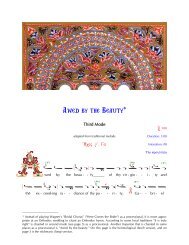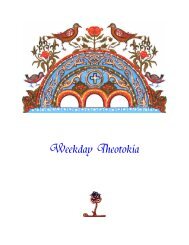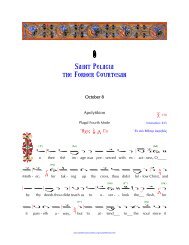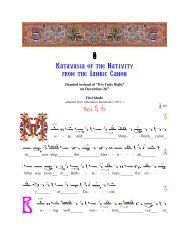Reading Psalmodia (PDF) - St. Anthony's Monastery
Reading Psalmodia (PDF) - St. Anthony's Monastery
Reading Psalmodia (PDF) - St. Anthony's Monastery
You also want an ePaper? Increase the reach of your titles
YUMPU automatically turns print PDFs into web optimized ePapers that Google loves.
INTRODUCTIONThis book offers a basic introduction to the notation in which the traditional chant of theByzantine churches is written.Many people automatically associate Orthodox worship with the rich choral traditions ofmusic that developed in Russia and the Ukraine. Georgian, Serbian, Romanian andBulgarian choirs also possess an extensive repertoire of choral liturgical music. Greek andArabic Byzantine churches, however, have retained a very different style of monophonicchant, a tradition which also lives on, side by side with the Slav choral tradition in manychurches in Romania and Bulgaria, and a closely related form of chant in Serbia. This musicis known as <strong>Psalmodia</strong>: it has common roots with Latin plainchant and with the chant of theSyrian and Armenian churches. It originates in the ancient musical traditions, both Jewishand Pagan, of the Eastern Mediterranean.When Christianity was established as the official religion of the Roman Empire the Churchacquired new and splendid buildings for worship. The rites and ceremonies of ImperialChristianity took on the solemnity and the grandeur of court ritual. A rich traditions ofhymnography developed, poets, composers and singers bringing their skills to the serviceof the Church.Side by side with relatively simple styles of music used for scriptural readings and thechanting of the psalms, more elaborate melodies were composed for the church’s newpoetry and for the liturgical texts. In the main cathedrals and churches, the Psaltes, theordained singer who played an important role in the services was expected to attain a highlevel of musical expertise. As the sacred chant developed through the Medieval period, newforms of notation were created to record it. The notation developed over the centuries untilit became a complex system of signs capable of expressing fine nuances of melodicmovement, intonation and expression.The fall of Constantinople to the Ottoman armies in 1453 paradoxically brought newopportunities for the Church's musicians; their musical skills and artistry were greatlyappreciated by the Ottoman Sultans and their nobility, and several of the famous Psaltaifound lucrative part-time employment as court musicians. Many became experts in the"Arabo-Persian" music of the Ottoman court, some learning the Arabo-Persian music beforestudying <strong>Psalmodia</strong>. In the eighteenth century Peter Lampadarios, whose compositionsshaped the entire psaltic repertoire in the modern period, was an expert in Islamic musicand taught the musicians of the dervish tekkes of Constantinople. KonstantinosProtopsaltes in the nineteenth century was the source for a small but useful and informativemanual on the modes of classical Ottoman music, or, as the book calls it “exoterikemousike”.Not surprisingly, during the centuries of Ottoman rule, the style and tonality of <strong>Psalmodia</strong>,always a living, developing musical tradition, took on a degree of Oriental colouring.4



